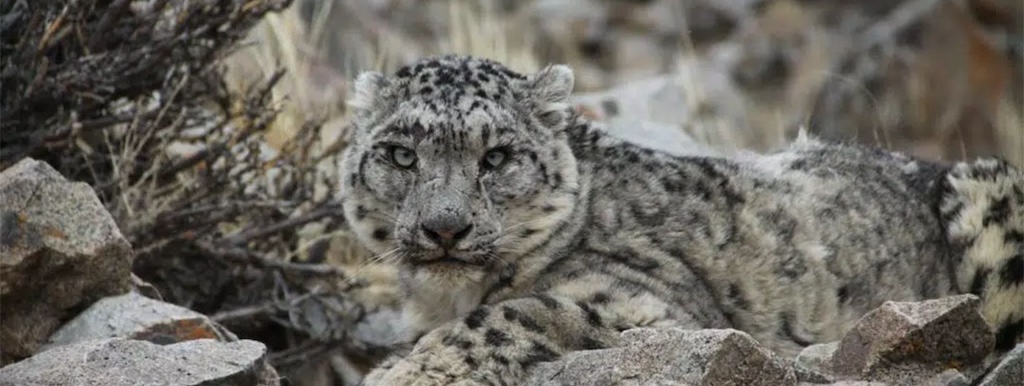Volume 5: Through the Eyes of the Snow Leopard
After years of careful planning and preparation, the first in a long list of eager travelers embarked on a private version of Quest for the Snow Leopard, an exciting Mongolia tour set in the most remote section of the Altai Mountains.
We asked Joseph Rohde, plein air painter and executive at Walt Disney Imagineering, to share some of his personal journal entries on his exclusive Mongolia tour to paint the rarely-seen ‘ghost cat.’ In a bid to conserve the habitat and the species, Rohde has sold the paintings entirely for fundraising, and exhibited the remaining paintings for sale in Ojai, California on May 17th.

We had to strap the wet paintings over the backs of our camels so that they would dry as we marched through the day. We have three camels now, having picked another one up at the last Kazakh gers. As we headed out after our lovely stay with our Kazakh hosts, Jim pointed down towards the next valley and said, “Well, at least we’ll have WiFi.”
Nothing would surprise me, so I thought nothing of it as we rode along until I looked up and realized what he was referring to. The larch forest on the slope of the mountain in front of us was eroded into a gigantic shape that said WIFI.
Well, there was no WiFi, but it is a lovely valley with a couple friendly families just getting ready to head out towards their winter pastures. Our path took us past old Kazakh cemeteries and many, many older tombs and standing stones, balbal, khirigsuur, and deer stones.
One area was defined by a very long double row of stones laid out to form an avenue that led up to a grave with a big carved warrior. Some of these stones are really tall, twelve feet or so, but most are not waist high. Beyond this area we found our campsite. Very rocky up above, and it looks like snow leopard habitat.
Today as we left camp we found snow leopard prints. Followed the prints up to the lair. As we left for the long ride to Lake Khoton, we rose out of the WiFi valley towards the pass, snow all around. To our right we suddenly came upon snow leopard prints in the snow, leading upwards into a craggy outcropping to our right.
Where the Wild Things Were: Ojai Quarterly expedition feature [read]
Since there is no record of snow leopards ever killing anyone, we decided to just dismount and follow the prints, which were pretty fresh, clearly laid down that morning. We hiked up in knee-high snow trying to parallel the path of the leopard as we went, until we started coming upon these areas that were more or less “roosts” where the leopard or leopards had rested or sat.
I sat in one roost, right next to where the leopard had sat and sketched the view that the leopard must have seen. It’s very clear how these spots are chosen because they seem to always have two views. This whole outcropping of rocks was clearly used to survey the valley below us, the pass itself and the valley beyond the pass.
After that, we remounted to cross the pass and head towards Khoton, passing one more set of tracks that led off to the east. Then, what a slog!! As we crossed the pass, before us was a huge seemingly endless plain of ice and snow bordered on east and west by snow-covered hills and mountains.
Far in front of us were the mountains on the far side of Lake Khoton. What we could not see from there was that the first huge plain, dropped off about in a steep glacial moraine and was hiding a second plain just as big, which hid a third long rocky slope. Camels and horses traveled together through most of this. It really looked like Antarctica or Greenland.
Now we’re encamped along the edge of Lake Khoton, which looks like Lake Tahoe in about 1840. Lost our camels for a while, which was nerve wracking, but Dalaikhan rode off and found them. Planning a couple paintings for tomorrow.
Lake Khoton is quite beautiful. Sort of surreal, seeing camels juxtaposed against a huge pristine body of water. We are camped under a huge craggy larch tree that I am painting. I’m also doing a painting of the snow leopard view from the sketch I made. Weather is suddenly very nice; shirtsleeve weather. Sunny, warm and comfortable.
We are taking showers in our shower tent, which is also very nice; water’s in a reutilized fire extinguisher, so actually good pressure. Dalaikhan is dismissing the third camel now, since from here on out there are no high passes to make them freak out and quit.
Our two camels should be able to do it.
The Mongolia Tour: More Information
This concludes Joe Rohde’s Mongolian tour series. For more information on Rohde’s incredible travels and his quest for the snow leopard, tune in to his personal blog or his Facebook page.

